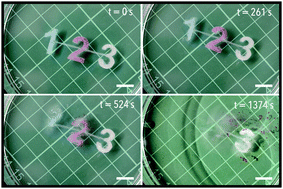Temporal and spatial programming in soft composite hydrogel objects†
Abstract
Soft composite hydrogel objects formed from the biopolymer sodium alginate, the enzyme urease, and oil droplets are formed by a simple gelation procedure to produce autonomous bodies with both time and spatial programming. These continuous objects of non-uniform dimensional composition selectively respond to an environmental stimulus of urea and change colour or disintegrate at pre-defined locations within the hydrogel structure after pre-set time intervals. The spatial and temporal responses of these hydrogels to an environmental stimulus are valuable tools in areas such as soft robotics.

- This article is part of the themed collection: 2017 Journal of Materials Chemistry B HOT Papers


 Please wait while we load your content...
Please wait while we load your content...